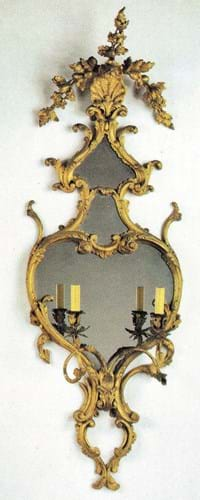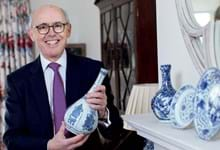
When: September 1985
What: at a Dreweatt Neate Fine Art picture auction – a format Stewart-Lockhart introduced to the firm – a 1720s landscape oil painting of a fox hunt by English sporting artist John Wootton (1686-1764) accounted for half the day’s takings. It hammered at £106,000 and for years held the firm’s house record.
When: May 1986
What: in 1986, Stewart-Lockhart was asked to sell selected lots by the Burdett family that had come from their ancestral home, Ramsbury Manor in Wiltshire. By the time of the auction, the manor was owned by property tycoon Harry Hyams, who was quietly filling it with his own choice of treasures.
The Burdetts had loaned key items to museums and Stewart-Lockhart had the task of “rounding these up, much to the disappointment of the curators”.
In his research, he discovered a set of six George III Chippendale-period carved giltwood girandoles (one shown above) that had hung in the saloon at Ramsbury.
Titled An Important Auction of English Furniture, the property of Sir Francis Burdett’s Will Trust, the auction’s proceeds totalled £250,000.
The six mirrors were bought by Harry Hyams for £90,000 to be repatriated back to Ramsbury Manor – in exactly the same place they had resided in the past.
When: 2005
What: a memorable private treaty sale brokered by Dreweatts to an institution on the other side of the world began in the year 2000 with a probate valuation of the Earl of Ducie’s estate in Gloucestershire.
In the family’s barn, Stewart-Lockhart came across a folio of more than 50 watercolours of birds and flowers, none of which were signed. “I had no idea who painted them but as one was of a kookaburra [shown below], I assumed that they might all be Australian,” he recalls.
Stewart-Lockhart and his friend, dealer and academic Christopher Foley, began painstaking research, including analysing the paints used and paper, as well as discovering how the watercolours came to be in the possession of the Ducie family.
The works were discovered to be by George Raper, a 19-year-old midshipman on the ‘First Fleet’ to Australia in the 1780s taking convicts to the newly established penal colony there. Two modern-day trips to Canberra by Stewart-Lockhart convinced the National Library of Australia that it had to have these drawings – among the first visual records of the continent by a European artist.
The deal was record-breaking for both buyer and auctioneer. Sold for a reputed £1m-plus, the private treaty sale of The Ducie Collection of First Fleet Art was the largest ever negotiated by a UK regional saleroom and, at the same time, a record amount paid for art by any Australian institution.
When: July 2017
What: having managed the sale of contents from Donnington Grove in 1991 while at Dreweatts, Stewart-Lockhart found the house to be a gift that kept on giving. After he moved to W&W in 2012 to become its managing director, the house’s owners consigned a succession of pieces into the Salisbury saleroom.
The most important of these was a George II giltwood wall mirror in the manner of Matthias Lock and John Linnell. Estimated at £20,000-30,000, it made £78,000 (plus 25% buyer’s premium).
“It shows the importance of keeping in touch with old clients, many of whom became friends,” Stewart-Lockhart says.















